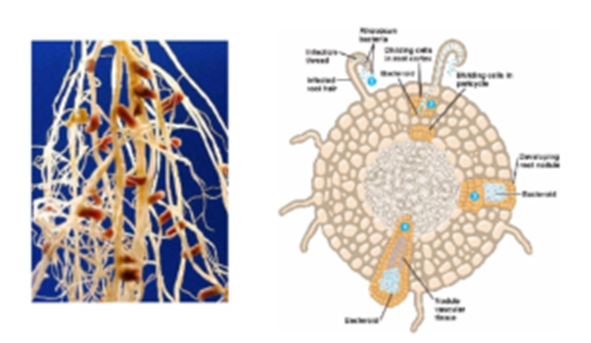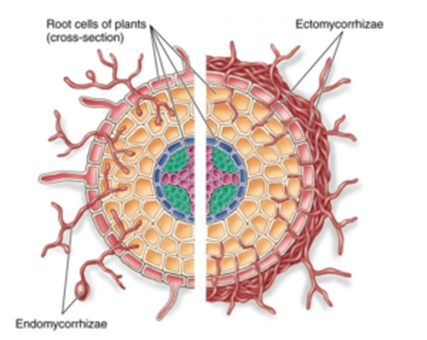Biology > Microbes in Human Welfare > Biofertilizers and BioControl Agents
In this article, we shall study the use of microbes as biocontrol agents and biofertilizers.
Microbes as Biocontrol Agents:
Chemical insecticides and pesticides are toxic and extremely harmful, to human beings and animals. These chemicals pollute the environment (soil, groundwater), fruits, vegetables, and crop plants. Our soil is also polluted due to the use of weedicides to remove weeds. To avoid this pollution and environmental degradation, biocontrol methods are used in place of chemicals. Biocontrol refers to the use of biological methods for controlling plant diseases and pests.
Microbial Pesticides:
In agriculture, there is a method of controlling pests that relies on natural predation rather than introduced chemicals. In this method, pests are kept in check, and not totally eradicated. Thus the food chains not disturbed e.g. Ladybird and Dragonflies useful to get rid of aphids and mosquitoes. Microbes used are either pathogens or predators or parasites on the pests. As it is natural predation it is not harmful.
An example of microbial biocontrol agent Bacillus thuringiensis (Bt) used to control butterfly caterpillar. They are available in sachets as dry spores, mixed with water and sprayed on plants. Fruits of these plants are eaten by insect larvae. In the gut of the larvae, the toxin is released and the larvae get killed. The bacterial disease will kill the caterpillars, but leave other insects unharmed. Now Bt toxin genes introduced into plants, which makes them resistant to insect pests. e.g. Bt cotton.
A biological control being developed for use in the treatment of plant disease is the fungus Tungus Trichoderma. Trichoderma species are free-living fungi that are very common in the root ecosystems. They are effective biocontrol agents of several plant pathogens.
Groups of Biocontrol Agents:
Pathogen: Bacteria
- Bacillus thuringiensis (Bt)
- Host range: Caterpillars (larvae of moths and butterflies). larvae of Aedes, black flies, some adult beetles, wax moths etc.
Pathogen: Fungi
- Beauveria bassiana
- Host range: Aphids, mealy bugs, mites, whiteflies, etc.
Pathogens: Protozoans
- Nosema locustae
- Host range: Grasshoppers, caterpillars, some corn borers and crickets.
Pathogen: Viruses
- Nucleopolyhedrovirus or NPV
- Host range: Gypsy moths and caterpillars
Microbial Herbicides/ Weedicides:
Pathogenic fungi as mycoherbicides:
- Phytopthera palmivora
- Alternaria crassa
- Fusarium sp.
Pathogenic bacteria as mycoherbicides:
- Pseudomonas sp.
- Xanthomonas sp.
- Agrobacterium sp.
Microbes as Biofertilizers:
The use of the chemical fertilizers to meet the ever-increasing demand for agricultural produce has contributed significantly to the pollution. Hence switching to organic farming is essential. Biofertilizers are organisms that enrich the nutrient quality of the soil. The main sources of biofertilizers are bacteria, fungi, and cyanobacteria.
Bacterial Biofertilizers:
The nodules on the roots of leguminous plants formed by the symbiotic association of Rhizobium. These bacteria multiply in the root and fix atmospheric nitrogen into organic forms, which is used by the plant as a nutrient. The specific Rhizobium is specific for a particular plant. e.g pea plant (Rhizobium leguminosarum) and for bean plant (Rhizobium phsaeoli).
Other bacteria can fix atmospheric nitrogen while free-living in the soil (examples Azospirillum and Azotobacter), thus enriching the nitrogen content of the soil.

Cyanobacterial Biofertilizers:
Cyanobacteria are autotrophic microbes many of which can fix atmospheric nitrogen. They are free-living, filamentous and may be aquatic or terrestrial. e.g. Anabaena azollae, Nostoc, Oscillatoria, Aulosira, Tolypothrix, etc. These blue-green algae have specialized cells called heterocytes which help in the fixation of nitrogen. In paddy fields, cyanobacteria (mainly Anabaena azollae, Nostoc) serve as an important biofertilizer.
Fungal Biofertilizers:
Fungi like mycorrhiza can also form symbiotic associations with plants. Many members of the genus Glomus form mycorrhiza. e.g. Ectomucorrhiza and Endomucorrhiza. The fungal symbiont in these associations absorbs phosphorus from soil and passes it to the plant.
Ectomycorrhizae form mycelium outside the root in the form of the mantle. It increases the surface area of the root. Due to which there is an increase in the uptake of water and nutrients. Due to which overall rate of growth of plant increases.
Endomicorrhizae grow in between and within the cortical cells of roots. The fungal hyphae penetrate the cells and form vesicles or finely branched arbuscles. Hence they are called Vesicular Arbuscular Mycorrhizae or VAM. Due to their presence, the plant can grow easily in the less irrigated land.
This association increases the resistance to root-borne pathogens, tolerance to salinity and drought and increase in plant growth and development.

Biodegradable Plastic:
Biodegradable plastic, like polyhydroxy butyrate (PHB) is being produced commercially by fermentation with the bacterium Alcaligenes eutrophus. Production of PHB can be easily achieved in tree plants like populous, where PHB can be extracted from leaves. Its production cost is high compared to synthetic plastics.
Edible vaccines:
The genes encoding the antigenic proteins of viruses and bacteria can be isolated from the pathogens and expressed in plants. such transgenic plants or their tissues producing antigens can be eaten for vaccination/immunization. Hence they are called edible vaccines.
The expression of such antigenic proteins in crops like banana and tomato are useful for immunization of humans since banana and tomato fruits can be eaten raw. Example: cholera and hepatitis B vaccine.
Previous Topic: Sewage Treatment and Biogas
Click Here for More Topics in Biology